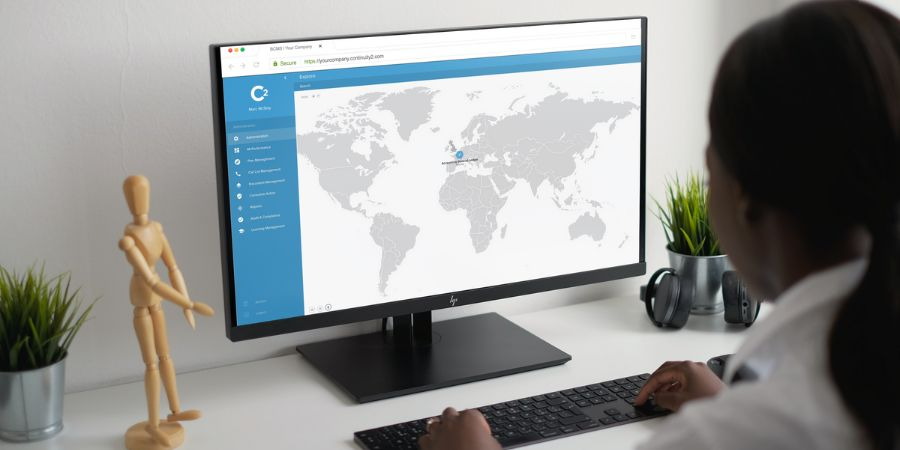BUSINESS IMPACT ANALYSIS (BIA)
Published on October 06, 2022
Last updated on May 22, 2025
Jump to a section
Understanding Impact to Ensure Operational Resilience
Do you understand how much damage can be caused to your business in the wrong situation? Operational resilience is never a given thing.
Most business owners and managers know that there are many factors that can put your business at risk. It’s important to be aware of the various internal and external factors that threaten the stability of your business processes. Assessing the financial implications of these risks, such as the costs associated with regulatory compliance and the impacts of natural disasters on manufacturing operations, is crucial.
Disruptions can come in many forms, and the business impact analysis is one of the best tools you can use to your advantage to ensure the continuity of your business functions. It’s one of the tools in your recovery strategies and risk assessment processes to recognise and minimise the impact of accidents, emergencies, risks, and other unexpected circumstances.

Examples of Business Disruptions or Disruptive Events
Identifying the different scenarios that cause business disruptions is important for business leaders and managers when conducting business impact assessments. Each scenario requires a different approach to protect your most crucial processes. Therefore, you should conduct different assessments for these business components and for a specific business function.
The following are some of the common disruptive events that businesses face:
- Physical damages to the business facility
- Damage to machinery or equipment crucial to essential business functions
- Natural disasters
- Supply chain interruption (such as the delay in the transportation of business goods)
- Temporary loss of utilities
- Employee absenteeism (such as sickness)
- Loss or damage to technology resources needed for important business processes
- Cyber attacks
- Compromised customer data
What is a business impact analysis?
Business impact analysis is the process of identifying and evaluating the possible effects and impacts of various incidents on your essential business processes. A business impact analysis template is a structured tool that helps organizations systematically document and evaluate the effects of potential disruptions on their operations. Critical activities are identified along with their supporting resources, dependencies, and recovery requirements. It specifically addresses the operational and financial impacts caused by any disturbances to essential functions.
What are the types of business impact that you want to avoid and therefore prepare for? Here are a few…
- Lost sales
- Delayed sales
- Regulatory fines
- Damage to business reputation
- Customer dissatisfaction
- Increased operating cost
- Contractual penalties
There are several processes involved when conducting a business impact analysis report. The goal is for service leads and department heads to forecast where and how these disturbances could occur and their level of risk to the entire organisation. In general terms, it’s a high-level assessment and planning for risks to business operations.
The business impact analysis is part of the organisation’s business continuity plan. It deals with the specific losses that the business will incur as a result of interruptions to critical business operations. For example, it calculates the total financial loss suffered when your business operations are forced to stop due to failure in your equipment or lack of manpower. Some areas of your business are more critical than others. Your ability to identify the most crucial business functions can help you prepare for unexpected events as part of your business continuity strategies and operational resilience planning.

Risk Assessment vs Business Impact Assessment
Before we go any further into explaining the importance of the BIA, let’s first clear up a common misunderstanding. While these two processes complement one another and work together, risk assessments and business impact assessments are not one and the same, and the terms should not be used interchangeably.
The first major difference between risk assessment and business impact assessment is in the purpose and how the resulting data is used. Risk assessment is a process of identifying and analysing potential threats to your business. It also determines the likelihood of that event happening to your business.
On the other hand, a business impact assessment focuses on the impact of those disruptive events on your business operations. It also looks into the severity of those effects. Collected data from structured questionnaires or interviews is crucial in both assessments to enhance understanding and facilitate decision-making.
Another point of difference between the two processes is the scope of the activity. Risk assessments can be performed to analyse the entire business. You can also conduct risk assessments on specific areas of the business, such as cybersecurity or communication. Risk assessment reports take into account threats that are not even directly targeted at the business. However, it still concerns the business because it limits the business’s ability to operate or service clients.
Meanwhile, the business impact assessment is concerned with how disruptions will affect the business, particularly the critical functions. Since every business differs in its business processes and critical functions, there is not one single approach that you can follow when conducting a business impact assessment. It varies from one organisation to another and depends on the nature of your business.
Types of Business Impact Analysis Report (BIA Report)
Generally speaking, there are two types of reports that you can prepare for business impact analysis: basic and comprehensive. The Basic Business Impact Analysis is recommended for less critical business functions. Any interruptions to these business units will lead to no significant impact on the overall business process.
Whereas the comprehensive business impact analysis report, as the name implies, is a more extensive business impact assessment involving the most crucial processes. Any form of disruptive event can impair your essential business functions, and depending on the type of disruption, can also affect your business reputation, lead to lost sales (or delayed sales), or impact cash flow management. These critical business components must be addressed and restored as quickly as possible, ideally within 24 hours or less.
A thorough understanding of the impacts of critical business processes is crucial to help choose the most suitable BIA report to conduct. It will also lessen the potentially damaging business impact of the business disruption. Additionally, defining metrics such as the recovery time objective (RTO) and the recovery point objective (RPO) is essential to assess the tolerable disruption time and the maximum acceptable data loss, respectively.
Why is Business Impact Analysis Important?
Most disruptions are unexpected or out of your control. When these emergencies arise, you have to be prepared for them. That's why conducting a Business Impact Analysis is an important preliminary step in your organisation's business continuity plan.
1. Planning for the future
It’s always crucial to have a plan during times of crisis so that you know what to do when a crisis does arise. Recovery objectives are essential components of business continuity planning, dictating the prioritisation of business functions in the aftermath of a disaster. It’s crucial for business continuity planning to make sure that you lessen the business impact that such disasters create. When you don’t have any prior plan, your actions and response to the situation are less effective because the consequences are not thoroughly evaluated.
A business impact analysis, on the other hand, is a thorough and comprehensive plan of action. It allows you to identify a recovery point of objective and the actionable steps that will get you there.
2. Prioritise critical functions
Not all aspects of your business require the same level of attention during times of crisis. Your ability to identify and focus your resources toward the recovery of vital processes is significant—it makes a crucial difference to your resilience and long-term survival and ultimately ensures business continuity.
3. Evaluate interdependencies
A comprehensive business impact analysis allows you to identify which functions of your business are interdependent on each other. This insight will be available to you only once you've mapped out the key business processes. Therefore, you will be able to identify the resource requirements for each unit and the impact of its loss on that specific business function, or any other processes.

Five key considerations for your Business Impact Analysis (BIA)
Here are five elements that you should consider for the business impact analysis. Appreciating each of these beforehand will increase the effectiveness of you BIA and its outcomes.
Executive Sponsorship
The success of business impact analysis lies in the amount of support provided by the top level of the organisation. An effective disaster recovery effort must involve every member of the organisation from top to bottom. Executive backing is vital so that you have access to the tools and resources needed to conduct risk management and develop actionable steps to minimise financial and operational impacts. The good news is, making a business case for BC planning and resilience is relatively easy to do - what executive doesn't want to ensure the business can operate and the doors remain open?
Understand the Organisation
You need a thorough understanding of the organisation's units and functions. Without this knowledge, it will be near impossible to identify risks and critical activities to come up with a priority plan based on which areas of the business are most vulnerable or crucial to the company's long-term survival.
Business Impact Analysis Tools
Aside from having a dedicated resilience team to help perform business impact analysis, tools come into play in conducting the report and risk assessments. Make sure you have adequate tools to gather relevant data and gain insights about those data, and software to analyze the financial and operational impacts of any disruption.
Business Impact Analysis Process
You need to have an efficient workflow mapped out for conducting the business impact analysis. You will require input and engagement from employees across the entire organisation to capture the critical processes pertaining to every department and function.
Traditionally, this is conducted via interviews and workshops, but there are alternative, more efficient ways of gathering such intel when you adopt business continuity management software for your organisation. Utilising a web-based platform means you can capture information remotely, eliminating the need for time-consuming meetings and email or paper chases between BC managers and various department leads.
To analyse potential impacts and begin building a recovery plan, each business unit and process must be carefully evaluated and you must identify potential interdependencies.
Business Impact Analysis Findings
The findings of the business impact report must be presented to the top executives and the corresponding units. It's important that everyone in the team is aware of the business continuity strategies and their designated roles. The cohesiveness of the implementation of your BIA findings can be critical to your fast recovery. It's all well and good having completed the analysis and compiled the report - but how does that actually translate to implementation during a business interruption?

What is the difference between BIA and BCP?
Business Impact Analysis (BIA) and Business Continuity Planning (BCP) are often used interchangeably. Therefore, many are of the assumption that these two are one and the same. The reality is that there are critical differences between these two and it's important to identify those differences because they serve a crucial role in your risk assessment and resilience efforts.
Business impact analysis is when you have a set of data that are analysed for their impacts and potential consequences to the business and its processes. It's a predictive tool for businesses to avoid significant impact in the financial and operational aspects. It is a cornerstone of your business continuity planning.
This leads us to the definition of business continuity planning, which is part of your business resilience and disaster recovery strategies. It will define a set of contingencies and best practices that will allow your business to resume operations as quickly and smoothly as possible.
In summary, both BIA and BCP are essential for any business's survival and disaster recovery. BIA is one of the main components that provide a strong foundation for continuity strategies and planning.
What is included in an impact analysis?
There is no one-size-fits-all approach to creating a business impact analysis. Every business process is unique and is composed of various business units. Therefore, every business impact analysis and business continuity plan should be tailored for each organisation. However, there are specific elements that go into every BIA report that you must consider as part of comprehensive business continuity planning measures.
The following is a guide to the essential steps that you must follow to ensure effective business impact analysis and recovery strategies.
Step 1: Put together a business impact analysis team.
Ideally, you should designate a BC/resilience team whose responsibility is to develop strategies to ensure business continuity, including overseeing the BIA. Every company is different, but the team could be composed of the following roles:
- BC Manager/Project Leader: The leader will serve as the primary contact for the business impact analysis process.
- Executive Sponsor: They will be responsible for delivering strategic input and in-depth insight into the critical business processes.
- Business Process Owners: You must assign a representative for every business unit in your organisation. They will be responsible for reporting the critical business operations and the relevant resources needed for each of these business units to function.
Step 2: Evaluate and assess critical information systems and crucial processes.
Once you have your business impact analysis team assembled, it's time to get to work. You need to come up with a way of collecting data, such as a business impact analysis questionnaire. You can use the business impact analysis questionnaire to gather information and insights from managers and others who are part of running your business.
It's also common to conduct personal interviews of key stakeholders, the senior management, and those directly involved with the critical functions. The senior management and those who are involved with the most crucial business functions will be able to provide valuable information about those business processes. They can also advise you on the potential consequences of a business interruption, regardless of the scale.
The questionnaire or process you use must be able to capture relevant information so you have all the inputs for making the report on the business impact. Some of the information you will need are:
- Human and technology resources needed
- Business partners
- Historical data
- Cash management flow
- Business continuity requirements
Make sure you examine closely how the type of business disruption and the length of the disruptive event can impact your organisation's ability to operate successfully. Make sure to identify costs linked with each disruption and set recovery time objectives in the report.
Step 3: Develop a report on the BIA Process aligned with the business continuity planning and disaster recovery plan.
The business continuity team must work together with the BIA team to build the recovery strategies for critical business processes. Once you have gathered the information, you must compile a detailed report. The report is the most crucial document that will come out of your business impact analysis process. The information contained in the report will help establish recovery strategies.
Make sure the report contains a detailed description of the operational and financial impacts resulting from a disruption. The analysis phase examines the order of priority for responding to these events that will allow you to recover important systems in the shortest amount of time possible.
The most critical business processes must be restored within 24 hours. Hence, it is crucial to define a recovery time objective.
Step 4: Implement the recommendations during business analysis to ensure business continuity.
After completing the business analysis and your team were able to establish recovery strategies, the next step is when you implement those recommendations. Make sure that you have fulfilled the resource requirements for every business unit and business process.
You must also regularly visit and review your business continuity planning strategies. The implementation of new systems might require new process resources and tools. You have to understand that your business functions and needs are not static. Therefore, you must be adaptable and regularly review the existing processes and be open to modifying them as needed.

See an Easier Way to Master your BIA
At Continuity2, we have developed a revolutionary new way to help you capture your critical activities and master your BIA in a fraction of the time, without the need for interviews and lengthy processes.
The BIA module makes it easy to engage not just business leaders, but all the process owners across the entire organisation. With dynamic reports and automated review reminders, your BIA feeds directly into your overall BC and resilience planning so you can rest assured that you're prepared for any disruption.
Our experts can also take you through a tailored BIA workshop to give you all the tools you need for creating and implementing BIAs in your organisation. If you'd like to see C2's software in action, book a demo today so we can show you how the BIA could look for your organisation.
Written by Richard McGlave
Founder & CEO at Continuity2
With over 30 years of experience as a Business Continuity and Resilience Practitioner, Richard knows the discipline like the back of his hand, and even helped standardise BS25999 and ISO 22301. Richard also specialises in the lean implementation of Business Continuity, IT Service Continuity and Security Management Systems for over 70 organisations worldwide.


Written by Richard McGlave
Founder & CEO at Continuity2
With over 30 years of experience as a Business Continuity and Resilience Practitioner, Richard knows the discipline like the back of his hand, and even helped standardise BS25999 and ISO 22301. Richard also specialises in the lean implementation of Business Continuity, IT Service Continuity and Security Management Systems for over 70 organisations worldwide.